Ghee:-
Ghee is basically a form of highly clarified butter obtained by heating regular butter which separate into liquid fat from its milk solid. To obtain the ghee, Butter is gently heated or simmered for longer time (as compare to normal clarified butter) until the milk solids get caramelized and browned & automatically sink to the bottom of the heating pan and water evaporates completely.
It is then strained to remove from its liquid fat resulting ghee has very low amount of milk protein(lactose) than butter. Due to browning of the milk solids while clarifying the butter to get ghee, it contributes to a stronger and nuttier flavor, as well as a darker color. Ghee is produced in India from both buffalo and cow milk
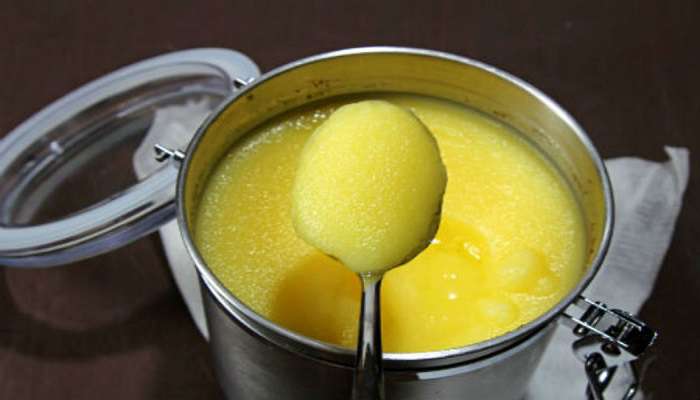
Pic source-daily hunt
Traditionally, ghee has been used as a cooking oil as well as in Ayurveda therapies. Ghee has a higher burning point than standard clarified butter, which means it is ideal for frying or sautéing foods.
Ghee is known as Ghrta or Ghrita in Sanskrit. It is an excellent Anupana (therapeutic vehicle) for transporting the properties of herbs to the deeper tissue layers of the body.
Ghee is one of the most common sattvic foods because its importance has been reflected in the ancient Vedas. Rice mixed with ghee and soma juice was considered the main diet of God because there are different Ayurvedic elements found in different types of milk, the properties of ghee will depend on its source. The most common and most often recommended ghee is Cow ghee.
Characteristic of Ghee:-
- Ghee is 100% fat with No colouring agent. Because ghee doesn’t contain any water therefore it will provide higher calories than butter per serving. For Example:- From One tablespoon of ghee(15gms) will provide 135 calories whereas one tablespoon of butter will provide only 102 calories.
- Ghee is a self-stable fat because of almost NIL moisture content (0.3%) in it and does not require refrigeration. The smoke point of ghee is also higher than butter (about 465 degrees versus 350 degrees for traditional butter).
- Ghee has shorter chain fatty acids contents & essential fatty acid such as Linolenic acid & Arachidonic acid, phospholipids, sterols, sterol esters, hydrocarbons, carotenoids (only in milk fat derived from cow) which are responsible for its better digestibility and anti-cancer properties. It also a good carrier of fat soluble vitamin such as Vitamin A, D, E & K. It also contains small amounts of charred casein and traces of calcium, phosphorus, iron and so on.
- The term “Desi ghee” is generally used for milk fat obtained from fermented milks whether from cow or buffalo in which curd has to be churned to form butter followed by heat clarification to separate out fat from non-fat medium.
- The flavour of Ghee can greatly influence by several factors such as fermentation of the cream or butter and the application of heat while melting of the butter to get ghee. The main flavoring compounds in Ghee are carbonyls, lactones and free fatty acids. It also has possible antioxidative properties, responsible for its stability by preventing oxidation. Therefore, it is more convenient product than butter and cream in the tropics regions like India because it remains stable under warm conditions.
- There is slight differences in fatty acid composition of ghee obtain from the cow milk and ghee obtain from Buffalo milk. The average unsaturated fatty acids content in buffalo ghee is 29 % & Saturated fat content is 71% whereas the average unsaturated fatty acid content in Cow ghee is 32% & Saturated fat content is 68%. This indicates that cow ghee is slightly more unsaturated than buffalo ghee.
- The only concern with ghee is of its cholesterol level (0.2–0.4%) which makes appreciable contribution to cholesterol intake when consumed at high level.
Shelf life of Ghee
One of the great qualities of ghee is its inherent shelf stability quality. The two things that can deteriorate or damage the quality of ghee are moisture content and sunlight. Moisture & sunglight can cause the ghee to oxidize and loose its nourishing properties. Also moisture can plan an important role on the growth of bacteria in ghee. Ghee remains soft at room temperature but turns firm and granular in the refrigerator.
The quality of ghee depends on many factors such as cream ripening quality, regional preference in taste, manufacture process of butter, clarification time& temperature of ghee & the packaging material used to store the ghee. The shelf life of ghee can range from 06months to upto 02 year of shelf life depending on the above factors.
- Generally ghee obtain from fresh cream/butter will have longer shelf life than ghee obtain from ripened cream.
- Cow ghee is more shelf stable than buffalo ghee due to the higher content of natural antioxidants. The low acidity and the presence of natural antioxidants in ghee could also contribute somehow to extend its shelf life.
- According to research, it has been observed that:- Ghee if stored at 20°C or below will solidify uniformly with fine crystals. Whereas if ghee is stored between 20°C – 30°C, it will solidifies with a loose structure. It is suggested that ghee should be stored at temperatures below 20°C to avoid layer formation
How to use Ghee?
Ghee has higher smoke point of 450 degree F as compare to butter which has 350 degree F. Due to high smoking point it is generally used for any kind of coking, frying, sautéing etc or simple melt and spread on the bread, chapati, or even used for tempering of food such as dal, curries etc.
Ghee tastes like slightly roasted & nutty flavour due to its browning of the milk protein during heating. Ghee does not have the creamy mouthfeel as compare to butter because of removal of milk fat.
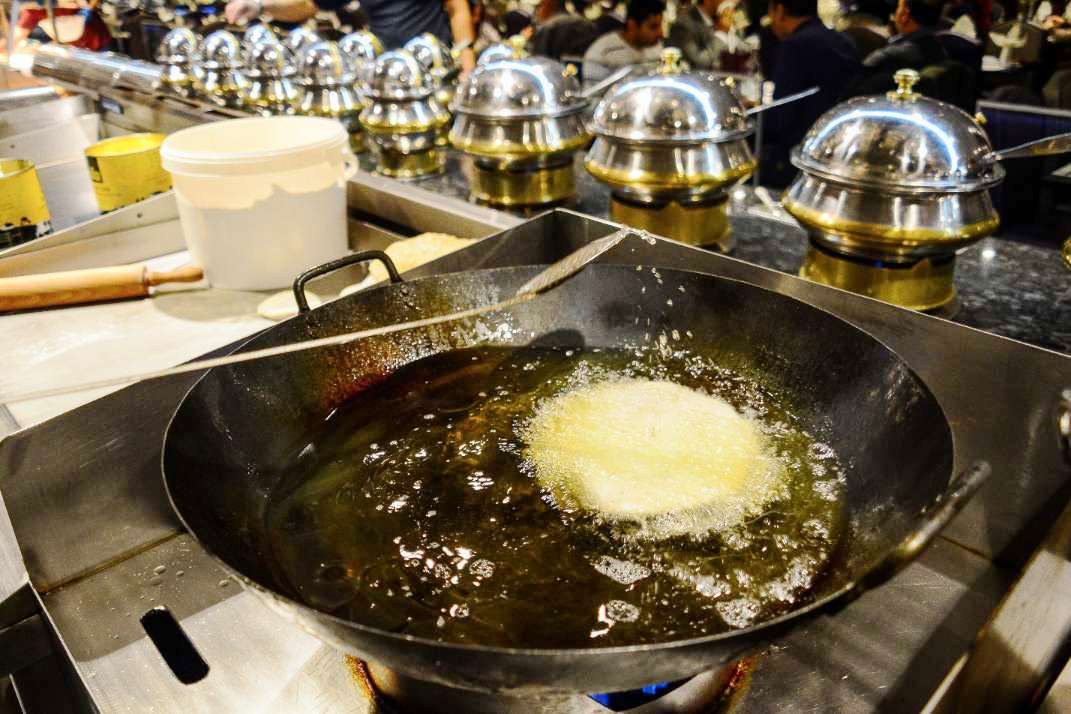
Pic source-royalnawaab.com
Example of use of Ghee in cooking:-
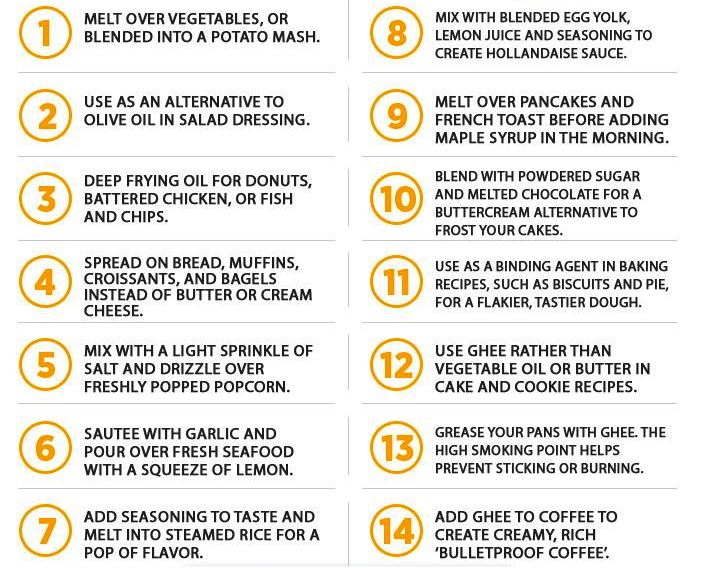
A brief history of Ghee:-
Ghee is a class of clarified butter that is originated in ancient India and for thousands of years ghee has been featured in Indian recipes and as per our Hindu mythology, Ghee attributes its origins to the divine and Ghee is a True food of the God. The consumption of milk, yoghurt and ghee has been part of the daily Indian diet since the first millennium BCE.
As per Hindu mythology, Lord Vishnu (Prajapati or lord of the creatures) rubbed his hands together to create the first ghee, which he then poured into flames to create his offspring. As a result, ghee is poured into sacred fires by Hindu to this day during pooja, Havan ceremony, marriage ceremony and several other ceremonies in india since ancient times. It also appears in Chapter 9 of the Bhagavad Gita, and in at least one of the hymns of Rg Veda from approximately 1500BCE. Lord Krishna was said to be very fond of Indian desi cow ghee as a young child.


Pic source- The goya journal & cowkart.com
As per ancient Sanskrit literature which describes ghee as food for the gods. Foods cooked in ghee are considered superior to those that eschew it. Vedic cooking divided all food into kacha khana/ कच्चा खाना (food not cooked in ghee) and pucca khana /पक्का खाना (food cooked in ghee) whereas in modern indian cooking it doesnot differentiate it between Kacha khana & Pucca khana but the practices are carried on during the religious ceremonies & festivals such Navratra, Chatha puja, Depawai etc.
Preparation and use of ghee in India
In India, ghee is made with churning of yoghurt first to obtain Makhan in a traditional terracotta pot. After collecting the makhan( butter) it is then brought to boil to evaporate the water content in the butter and when the milk protein gets brown or caramelized it settle on the bottom of the heating pan. Then the melted butter is carefully strained to get Ghee.

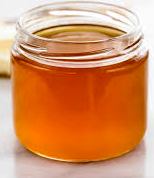
The only difference between ghee and clarified butter is that ghee is cooked until the milk solids are slightly browned which adds a nutty flavor to the finished product. In India, ghee is referred to as desi ghee which means real ghee.
What is Vanaspati Ghee:-
Vanaspati Ghee is made from palm or palm olein oil which is fully or partially hydrogenated and then hardened to produce vanaspati Ghee. The palm oil is bright orange in color due to high amounts of carotene pigments. The oil is semi-solid at room temperature and is highly resistant to oxidation and prolonged exposure to heat. Palm oil is widely used in margarine and vegetable shortenings.
Vanaspati ghee is very high in trans fats, which may compose up to 50%. Although it is much cheaper than desi ghee. Vanaspati means any refined edible vegetable oil or oils subjected to a process of hydrogenation in any form. Trans Fatty acids are unsaturated fatty acids produced when unsaturated oils are converted to semi solid by a process called hydrogenation.

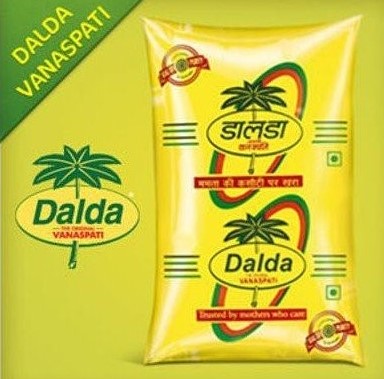
Pic source- Indiamart
In India vanaspati ghee is popularly known as Dalda. Although Dalda is a popular & leading brand name of Vanaspati ghee in India but its brand is so much popular in India that many people unknowingly or knowingly started calling vanaspati Ghee as Dalda.
What is the difference between Pure Ghee & Vanaspati Ghee & which one is the best?.
The primary difference between desi ghee and dalda is, dalda is the example of hydrogenated vegetable fat, whereas Pure (desi) ghee contains saturated fats. Dalda contains trans-fat mostly, which is marginally found in pure ghee.
Cow ghee contains only 2-3% of trans fat and it is the purest form of ghee, so it is safe to consume whereas Vanaspati Ghee (DALDA GHEE), which contains 40% trans fatty acid can be associated with health disorders such as insulin resistance and psychosocial stress. The higher intake of foods that contain Trans Fatty Acid is linked to increased risk of cardiovascular diseases.
Why need arises to produce Vanaspati ghee in India:-
The need of Vanaspati Ghee arises in India during the early 1930 when scarcity of ghee began to be felt in India due to the growth of Population, reduction in cattle population, expansion of urban areas etc. Hence the need for some less expensive substitute of ghee was felt in India.
Thus, the story of vanaspati began in India by importing the technique of partially hydrogenized vegetable oil (PHVO) from Holland. Its appearance and flavor are very similar to the traditional ghee. The first factory was set up in Bombay by the Indian Vegetable Product Ltd with a capacity of 303 ton of vanaspati per annum followed by four more mills setup in Bombay before 1934. The manufacture of vanaspati thus became one of the major food industries in the country. During 1950, vanaspati was recognized as a wholesome food fit for consumption as a fat.
Comparative testing of Cow Ghee brands by Consumer affairs India:-
Consumer affairs India has tested 11 popular brands of Cow ghee in the month of January 2020. The comparative testing was carried out at a NABL accredited laboratory. The key parameters for which the Ghee brands were tested included milk fat, vitamins A, saturated fat, PUFA, MUFA, and trans-fat.
Their Test result are as Under:-

Source-consumeraffairs.nic.in
As per the consumer affairs comparative testing Ananda Cow Ghee and Amul cow ghee has secured the number 1 position.
Ayurvedic properties of Ghee:-
According to Ayurveda, Ghee pacifies pitta and vata and is acceptable, in moderation, for kapha. It nourishes ojas, tejas and prana. It is good for improving memory and lubricates the connective tissue.
Ghee makes the body flexible and, in small doses, is tridoshic. Ghee is a yogavahi—a catalytic agent that carries the medicinal properties of herbs into the seven dhatus or tissues of the body.
It nourishes all the tissues of the body, including the nervous system, translating into calm energy throughout the day.
Nutritional value of ghee:-
The approx. nutritional value of 01 tsp (15gms) of ghee are:- Energy- 130Kcal, 8% Vitamin A, 2% Vitamin E & 1% Vitamin K of the recommended daily intake.

Precautions while using Ghee: – Persons who already have high cholesterol or suffer from obesity should be cautious in using ghee. Ghee is not to be used when there are high ama (toxic) conditions.
Allergies related to Ghee: – Ghee may be less likely to cause allergic symptoms than butter since the clarification process removes most of the lactose and casein—components that typically bring about adverse reactions.
Why cheap brands of Pure Ghee are generally adulterated.
The market price of ghee is almost 03 times more than the price of edible vegetable oils/fats. The supply of ghee is also far short of its demand. These gaps between price and availability leads to several malpractices. Adulteration of ghee is more common malpractice in India because it will fetch more profit to the traders and also result into increased supply. The adulteration of ghee can start at the stage of milk itself. Water emulsion of coconut, groundnut and other cheap oils are added to milk or cream. On souring and churning, these transfer to butter, and thus on boiling of butter or cream pass on to ghee.
Two types of adulterants are generally used in ghee:
- Adulterated with vegetable oils/fats
- Adulterated with animal body fats.
Realizing the problem of adulteration of ghee with vegetable oils/fats, the introduction of an easily detectable ‘marker’ in vanaspati has been made compulsory by the Vegetable Oil Products Control Order, which is under the control of Ministry of Food and Agriculture, Govt. of India. According to this order, vanaspati shall contain raw or refined sesame or Til oil not less than 5% by weight. The Baudouin colour test enables vanaspati containing sesame oil to be detected in adulterated ghee.
How to check the adulteration in Ghee: –
Several tests have been developed from time to time to detect adulteration of ghee with vegetable oils/fats and animal body fat. Under the PFA rules the Baudouin test, which should be negative is mandatory, whereas Agmark standards recommends that Baudouin test and Phytosterol Acetate test should be negative. There is no reliable simple method, which can distinguish genuine ghee from ghee containing as high as 20-30% animal body fats.
The Baudouin test for sesame oil consists essentially in treating the fat with concentrated hydrochloric acid and adding to the extract a 2% solution of freshly distilled furfural in 95% ethyl alcohol. Development of a permanent pink colour indicates the presence of sesame oil (alternatively vanaspati) in ghee. This test can detect upto 3% sesame oil in ghee.
The Phytosterol acetate test also detects the adulteration of ghee with vegetable oils. Ghee is an animal fat and contains cholesterol while all vegetable oils contain sterols of other types which are together termed phytosterol.
Some common method: –
- If ghee melts immediately and turns dark brownish in colour, then it is pure ghee. If it takes time to melt and turns into light yellow in colour, then it is adulterated.
- Ghee are generally adulterated with Coconut oil. To check the adulteration with coconut oil, melt some ghee in a glass jar using the double-boiler method and pour into the glass jar, put this jar in the fridge. If ghee and the coconut oil will solidify in separate layers, then the ghee is adulterated otherwise the ghee will be pure.
- Ghee can also be adulterated with Vanaspati ghee. To Check the adulteration with vanaspati oil. Heat a tablespoon of ghee in a test tube and add an equal amount of concentrated HCl with a pinch of sugar. Shake well to mix the ingredients. The appearance of pink or red colour in the lower layer shows the sample is adulterated with rancid ghee like hydrogenated oils/ vanaspati ghee.
Ref:-The ayurvedic institute.
EPCI University, USA
Dairy technology blogpost
